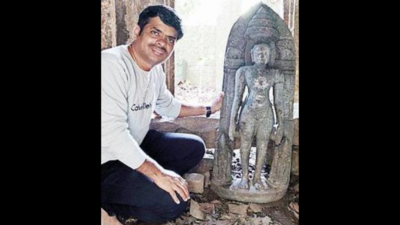Top Searches
- News
- City News
- bengaluru News
- 11th C inscriptions found at abandoned Jain temple in Karnataka
11th C inscriptions found at abandoned Jain temple in Karnataka

Nitin HP stumbled upon the inscriptions at Doddakanagal village in Somawarpet taluk in an old Jain Basadi
BENGALURU: Three Kannada inscriptions dated to the 11th century have been discovered in an abandoned Jain temple at Doddakanagal village in Kodagu's Somawarpet taluk. The temple itself was rediscovered a few decades ago. While searching for an inscription that has been documented at the same village, Nitin HP, an associate director at Wipro and an amateur historian, stumbled upon the three inscriptions.
The ancient basadi (Jain temple) is in the middle of agricultural fields belonging to BE Sandesh. It is in ruins and has only a few standing structures. Of the three inscriptions, one is on the pedestal of a Jain Tirthankara idol, the second is along the ruined pedestal below the idol of a Yakshi and the third is on a flat stone.
The inscription on the Tirthankara idol's pedestal gives a clear hint of the date to which it belongs. "The inscription states that Tribhuvanamall Kongalvadeva, a disciple of Sri Prabhachandra Siddanatha Deva who was the disciple of Sri Meghachandra Trividyadeva of Mula Sangha Kundakondanvaya Postaka Gachha, got the idol made as a homage to all departed souls and with an intention that good fortune should prevail upon all. Tribhuvanamalla Kongalvadeva is a ruler of Kongalva dynasty and we know his rule corresponds to 1066 to 1100 CE. Hence the period of this inscription can be attributed to 11th century CE," said Nitin.
The inscription below the Yakshi idol is four lines long but most of it is broken and only two words could be deciphered. "All we can read are the words 'Mulasangha' and 'Punyartha'. This indicates that the person who got it engraved might be a disciple of a guru who belonged to 'Mulasangha' and the word 'Punyartha' indicates that this had some content related to the well-being of the people. The word 'Mulasangha' helps us conclude that this is a Jain inscription," Nitin said.
The third inscription on the stone slab is 14 lines long. But except for the carvings of the sun and moon on the top, none of the words in it can be read. Only a few individual alphabets can be made out which don't throw light on anything.
Kodagu region had Jain kings called Kongalavas during the late first millennium and the early second millennium. However, there are hardly any Jain families in the district today.
"This land where the Basadi, idols and the inscriptions were found belongs to Kodavas and they offer puja to this deity once a year in April after the first rain. There are no Jain families in the vicinity," Nitin said.
The ancient basadi (Jain temple) is in the middle of agricultural fields belonging to BE Sandesh. It is in ruins and has only a few standing structures. Of the three inscriptions, one is on the pedestal of a Jain Tirthankara idol, the second is along the ruined pedestal below the idol of a Yakshi and the third is on a flat stone.
The inscription on the Tirthankara idol's pedestal gives a clear hint of the date to which it belongs. "The inscription states that Tribhuvanamall Kongalvadeva, a disciple of Sri Prabhachandra Siddanatha Deva who was the disciple of Sri Meghachandra Trividyadeva of Mula Sangha Kundakondanvaya Postaka Gachha, got the idol made as a homage to all departed souls and with an intention that good fortune should prevail upon all. Tribhuvanamalla Kongalvadeva is a ruler of Kongalva dynasty and we know his rule corresponds to 1066 to 1100 CE. Hence the period of this inscription can be attributed to 11th century CE," said Nitin.
The inscription below the Yakshi idol is four lines long but most of it is broken and only two words could be deciphered. "All we can read are the words 'Mulasangha' and 'Punyartha'. This indicates that the person who got it engraved might be a disciple of a guru who belonged to 'Mulasangha' and the word 'Punyartha' indicates that this had some content related to the well-being of the people. The word 'Mulasangha' helps us conclude that this is a Jain inscription," Nitin said.
The third inscription on the stone slab is 14 lines long. But except for the carvings of the sun and moon on the top, none of the words in it can be read. Only a few individual alphabets can be made out which don't throw light on anything.
Kodagu region had Jain kings called Kongalavas during the late first millennium and the early second millennium. However, there are hardly any Jain families in the district today.
"This land where the Basadi, idols and the inscriptions were found belongs to Kodavas and they offer puja to this deity once a year in April after the first rain. There are no Jain families in the vicinity," Nitin said.
FOLLOW US ON SOCIAL MEDIA
FacebookTwitterInstagramKOO APPYOUTUBE
Start a Conversation









